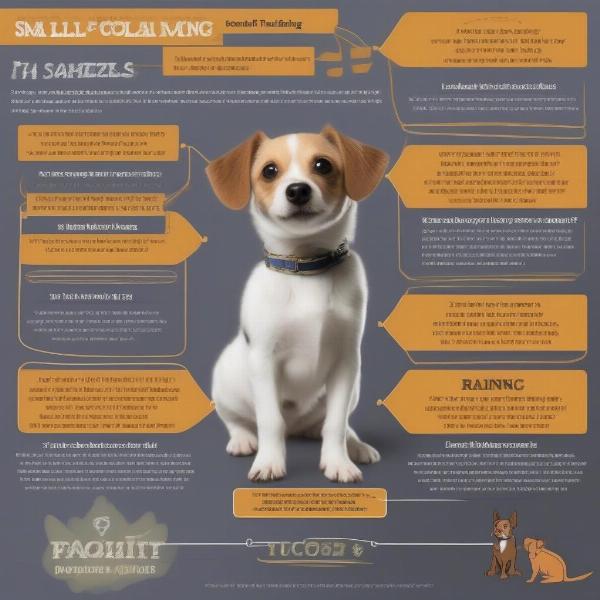Training collars can be a valuable tool for training small dogs, but choosing the right one and using it correctly is crucial. This guide will help you understand the different types of training collars available, how to choose the best one for your small dog, and how to use it effectively and humanely. We’ll cover everything from basic obedience to addressing specific behavioral issues.
Types of Training Collars for Small Dogs
There are several types of training collars designed for small dogs, each with its own pros and cons. It’s essential to choose a collar that suits your dog’s size, temperament, and training needs.
Flat Collars
Flat collars are the most common type of collar and are suitable for everyday use. They are typically made of nylon or leather and are used for identification tags and leash attachment. While not specifically designed for training, they can be used for basic obedience training with small dogs.
Martingale Collars
Martingale collars are designed to prevent dogs from slipping out of their collars. They tighten slightly when the leash is pulled, but unlike choke chains, they have a limited slip, preventing them from choking the dog. This makes them a safer option for small breeds.
Harnesses
Harnesses are a good option for small dogs who tend to pull on the leash or have respiratory issues. They distribute pressure across the chest and shoulders, reducing strain on the neck. Harnesses come in various styles, including front-clip and back-clip harnesses.
Choosing the Right Training Collar
 Choosing the Right Collar for a Small Dog
Choosing the Right Collar for a Small Dog
Selecting the appropriate training collar for your small dog depends on several factors. Consider your dog’s breed, size, temperament, and training goals. A collar that works well for one dog may not be suitable for another.
Consider Your Dog’s Size and Breed
Small dogs have delicate necks, so it’s important to choose a lightweight collar that fits properly. A collar that is too tight can cause discomfort and even injury, while a collar that is too loose can slip off.
Think About Your Dog’s Temperament
If your dog is prone to pulling or has a sensitive temperament, a harness may be a better option than a collar. A harness distributes pressure more evenly and is less likely to cause discomfort.
What Are Your Training Goals?
The type of training collar you choose will also depend on your training goals. For basic obedience, a flat collar or martingale collar may be sufficient. For more advanced training or behavioral modification, you may want to consider a specialized training collar.
Using a Training Collar Effectively
Once you’ve chosen the right training collar, it’s important to use it correctly. Consistency and positive reinforcement are key to successful training.
Positive Reinforcement
Always use positive reinforcement methods when training your small dog. Reward good behavior with treats, praise, or toys. Avoid using punishment, as this can create fear and anxiety.
Consistency is Key
Be consistent with your training. Use the same commands and techniques each time you train your dog. This will help them learn more quickly and effectively.
Start Slowly
Introduce the training collar gradually. Let your dog get used to wearing the collar before you start using it for training. Keep training sessions short and positive.
Conclusion
Choosing and using a training collar for small dogs requires careful consideration and proper technique. training collars for small dogs can be an effective training tool when used humanely and in conjunction with positive reinforcement. Remember to choose a collar that suits your dog’s individual needs and always prioritize their safety and well-being. training collar for small dog By understanding the different types of collars available and implementing consistent, positive training methods, you can help your small dog learn and grow into a well-behaved companion. best training collar for small dogs
FAQ
- What is the best training collar for a small dog that pulls? A harness is often the best choice for small dogs who pull, as it distributes pressure more evenly and reduces strain on the neck.
- Can I use a training collar on a puppy? Yes, but it’s essential to choose a lightweight collar designed for puppies and use gentle training methods.
- Are choke collars safe for small dogs? Choke collars are generally not recommended for small dogs due to the risk of injury.
- How do I introduce a training collar to my small dog? Start by letting your dog wear the collar for short periods, gradually increasing the time. Reward them with treats and praise.
- How long should training sessions be? Keep training sessions short and positive, typically no longer than 10-15 minutes.
- What if my dog doesn’t respond to the training collar? Consult with a professional dog trainer for personalized guidance.
- Are there any alternatives to training collars? Yes, positive reinforcement methods, such as clicker training, can be very effective.
ILM Dog is a leading international dog website dedicated to providing expert advice on dog care and training. We offer comprehensive resources on breed selection, health, training, nutrition, grooming, and much more. Our goal is to empower dog owners with the knowledge and tools they need to provide the best possible care for their canine companions. Whether you’re a new dog owner or a seasoned pro, ILM Dog is your trusted source for all things dog-related. For expert advice and personalized support, contact us via email at [email protected] or by phone at +44 20-3965-8624.